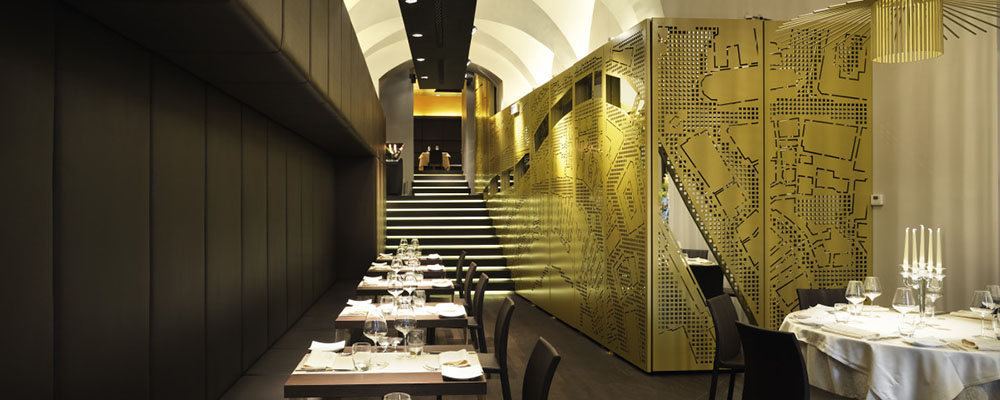Opened in July 2008, Valvas’or is a restaurant, located at Stari Trg 7, Ljubljana. It owes its name to the famous Slovene man Janez Vajkard Valvazor, who was born in the house across the street from the restaurant. Hiding behind the typology of his name is a dash of what composes the red thread of the establishment; history, novelty, gold (prestige).
The restaurant is designed as a modern, sober space, within an old, arched tavern, accessible from the ground floor. The idea was to create a space where old and new harmoniously unite to create the restaurant’s unique image. To preserve the charm and character of the old space, maintain a feeling of spaciousness, add the necessary elements for the activities currently implemented, design the whole in the spirit of our time, add a metropolitan touch and create a gourmet atmosphere in which to enjoy delicious food – such was the ambition of the authors.
The elongated restaurant is built on three levels. The ground floor level with the view of the street is the widest. Here we find the entrance to the restaurant, following which, on the left-hand side, stands a set of tables placed before a brown leather box-element, which serves as the sitting area. To the right-hand side, beneath a pair of gold metal chandeliers, are two round tables suitable for 6 to 8 guests. The tables are situated in front of a golden, perforated metal wall, which breaks at an angle of 90 degrees to continue into the interior of the room, where the ground-and second floor of the restaurant are connected with a flight of stairs. The metal wall continues on the second floor, where, at the kitchen entrance, it breaks again to swathe the sanitary facilities and storage cabinets it conceals. The wall consists of a perforated metal sheet bearing a motif of 16th century Ljubljana, behind which a mirror has been placed to give the room greater depth and to give the wall an impression of lightness.
The second floor comprises the kitchen entrance, two console tables with bar stools and additional stairs, which lead to the golden room, the upper floor of the restaurant. Here we encounter a bar, seating in guise of a leather box-element and tables for those who wish to withdraw and be less exposed to the street.
The restaurant’s interior is dominated by warm tones. The walls are of a creamy beige colour, the seats are chocolate brown, the floors and tables are in teak and the wall, chandeliers and upper room are golden. The sole black element is a rectangular conduit that uninterruptedly winds throughout the entire establishment and serves lighting and ventilation purposes. In an attempt to highlight the old, pre-existing volume, the authors chose to hide all the lighting in a black technical conduit, with the exception of two gold chandeliers above the round tables and the indirect lighting on the box-element seating, which illuminates and highlights the vaults of the room. The sanitary facilities, which are hidden behind the golden wall, are black, except for the big white sinks and WCs.
The restaurant Valvas’or is intended for lovers of good food and the downtown atmosphere, who do not necessarily associate this with all that characterises previous centuries.
